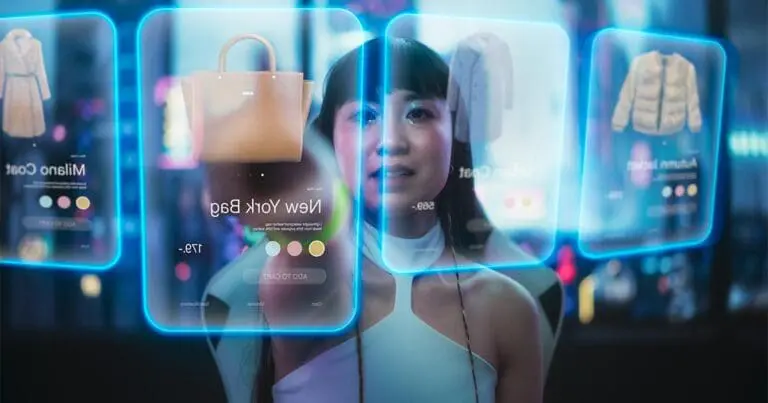What is Augmented Reality in UX Design?

Augmented Reality (AR) blends digital elements with the physical environment, creating interactive and immersive experiences.
AR has become increasingly prevalent in the tech industry, reshaping user experience (UX) across retail, education, healthcare, and gaming sectors.
This remarkable technology allows users to see the real world augmented with digital information, enhancing the way we interact with our surroundings.
This article explores how AR can transform UX design and the roles required for successful AR integration, such as developers, UI/UX designers, and content creators, to bring augmented experiences to life.
The impact of AR on user experience (UX)
The impact of AR on user experience (UX) means understanding the definition of augmented reality and the goals of AR in UX.
Definition of augmented reality
Augmented reality enhances the real world by overlaying virtual elements on top of physical objects and environments.
Unlike Virtual Reality (VR), which immerses users in a completely digital environment, AR enables users to interact with digital objects within their physical space via mobile devices or AR headsets.
Goals of AR in UX
Key goals of AR-enhanced user experiences include interactivity, engagement, and immersiveness.
These principles underpin AR applications that blur the line between virtual environments and the real world, offering unique opportunities for users to explore and interact with virtual objects naturally.
This seamless integration aims to enrich the user’s perception of reality, transforming ordinary environments into dynamic and interactive spaces.
Applications of AR in UX
Examples of of AR in UX include:
- Education: Enabling interactive learning through digital overlays on physical books and educational environments.
- Retail: Allowing users to visualize products like furniture or clothing in their own homes via AR apps.
- Gaming: Creating interactive experiences that merge digital characters and 3D objects with the real world.
- Healthcare: Assisting in medical training and diagnostics with enhanced visualization and haptic feedback.
- Real Estate: Helping users explore properties remotely with AR-assisted walkthroughs.
Key benefits of AR for improving user experience
Key benefits of AR for improving user experience include increase interactivity and engagement, personalization and customization, and improved training and learning experiences.
Increased interactivity and engagement
AR provides opportunities for users to interact with virtual elements in their real environment, bridging the gap between digital and physical realities.
This capability has significantly enhanced engagement in interactive experiences, such as gaming — e.g., “Pokémon Go” — and mobile applications for shopping, allowing users to preview how a product fits in their personal space.
Such immersive interactions not only boost user involvement but also increase the likelihood of positive behavioral responses towards products and brands.
Personalization and customization
AR offers personalized experiences by tailoring content based on user context and preferences.
For example, retail AR applications enable users to visualize how different product configurations or colors would look in their own homes.
Meanwhile, educational apps can provide personalized training modules, adjusting to the learner’s pace and preferred learning style.
Enhanced visualization and information access
With AR, users can access detailed insights by overlaying digital information onto physical objects, providing an enriched understanding of their environment.
Architects benefit immensely from this technology, as they can visualize 3D space and designs within a real-world environment, facilitating better planning and execution.
Additionally, technicians can access audio narrations and schematics directly on equipment, streamlining maintenance and repair processes with interactive guides.
Improved training and learning experiences
Augmented reality features allow for immersive training environments, providing safer and more effective learning opportunities.
Healthcare professionals can practice procedures with minimal risk, while manufacturing trainees can simulate scenarios to improve technical skills.
This approach significantly reduces the margin for error when these skills are applied in real-world situations, enhancing overall safety and efficacy.
Roles required to integrate AR into UX
Roles required to integrate AR into UX include AR developers/engineers, UX/UI designers, 3D artists/modelers, AR product managers, and quality assurance testers.
AR Developer/Engineer
An AR Developer/Engineer designs and codes AR applications using software development kits (SDKs) and programming languages like Unity, C#, and C++.
They are responsible for creating intuitive interfaces and enhancing interaction design to ensure a seamless user experience.
Their expertise is crucial in effectively integrating digital elements with the physical world, making AR applications both functional and engaging for users.
UX/UI Designer
The UX/UI Designer ensures seamless user experience design by developing the overall design journey and visual design.
They specialize in creating intuitive interfaces that align with the intended user flow and deliver engaging AR interactions.
This role incorporates user research and feedback into the design process, making sure AR features are accessible, usable, and satisfying across different devices and platforms.
3D Artist/Modeler
3D Artists/Modelers play a pivotal role in the creation of augmented reality experiences by designing 3D objects, environments, and animations using advanced 3D modeling software.
They focus on ensuring these digital assets are not only visually appealing but also optimized for integration within the AR design process, aligning with the application’s functional and aesthetic requirements.
Their expertise in texture, color, and lighting is essential in making the virtual elements realistically blend with the physical world, enhancing the overall user experience.
AR Product Manager
The AR Product Manager plays a critical role in shaping the future of augmented reality products.
They guide the AR product vision and strategy, ensuring that all project components—ranging from technical development to user experience design—align with the overarching business goals.
By coordinating closely with stakeholders, technical teams, and the design team, they guarantee the AR application delivers tangible value and effectively meets user needs.
Quality Assurance Tester
A Quality Assurance Tester meticulously evaluates the augmented reality application to identify and resolve design flaws, focusing on optimizing user satisfaction.
They conduct extensive tests to ensure the application’s performance is consistent across a variety of physical environments and adapts seamlessly to different mobile screen sizes.
This role is crucial in guaranteeing that the AR experience is smooth, immersive, and free from technical disruptions.
The future of AR in UX
AR is likely to play a transformative role in enhancing user satisfaction across sectors, revolutionizing how users interact with products and services by blending digital information with the physical world.
By building multidisciplinary teams that include developers, designers, managers, and testers, organizations can ensure the seamless integration of AR into their products, creating more immersive and interactive user experiences.
To fully leverage this innovative technology’s potential, companies should explore AR technology and invest in assembling a team with the right mix of skills and roles.
This strategic approach will empower companies to stay competitive by delivering cutting-edge, augmented reality-enhanced products and services.
Looking to hire top-tier Tech, Digital Marketing, or Creative Talent? We can help.
Every year, Mondo helps to fill over 2,000 open positions nationwide.
More Reading…
- How Technology is Shaping the Future of Public Transportation
- Benefits of Serverless Computing For Startups
- How to Adapt AI Customer Support Strategies in the Era of Chatbots
- Top AI Resume Builders to Get a Job in 2024
- Effective Workday Implementation & Key Roles to Hire
- Assessing Your AI Needs: How To Conduct an AI Gap Audit
- Choosing the Right UX Designer to Hire for Your Team
- Fostering a Listening Culture in Your Organization
- Machine Learning vs AI: Recruiting and Hiring the Right Talent
- AI Overwhelm & 3 Things You Can Do Now to Get Started
- Leveraging AI for System Integration & the Demand for AI Talent
- AI You Didn’t Realize Your Organization Is Already Using
- Quantifying a Project Manager’s Success to Advocate for Hiring
- Highest Paid Data Science Roles & Top Salaries



